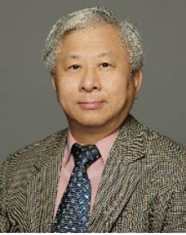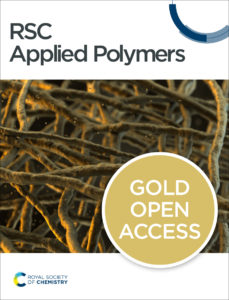To celebrate the growth and development of the RSC Applied Polymers community and to highlight the remarkable authors who continue to contribute their high quality work to the journal we would like to share the opinions and insights of these authors through this introductory blog post. Once dubbed #RSCAppliedfirst50, our blog posts aim to give a voice to the authors behind the research and hope that their insights might shed light upon growing challenges and progress in polymer science and its applications.
In this edition, we hear from Richardson Lawrance and Partha Chowdhury about their study entitled The Luminous Frontier: Transformative NIR-IIa Fluorescent Polymer Dots for Deep-Tissue Imaging.
Want to know more about their work? Read the full paper here
An introduction to ‘The Luminous Frontier: Transformative NIR-IIa Fluorescent Polymer Dots for Deep-Tissue Imaging’ by Richardson Lawrance, Partha Chowdhury, Hong-Cheu Lin and Yang-Hsiang Chan.
In our recent review article published in RSC Applied Polymers, we delve into the cutting-edge field of deep-tissue imaging, highlighting the advancements in fluorescence imaging within the second near-infrared window (NIR-II, 1000–1700 nm). This wavelength range, particularly the NIR-IIa region (1300–1400 nm), has emerged as a powerful tool for probing biological processes with unparalleled depth and clarity. Among the various NIR-II fluorophores, polymer dots (Pdots) stand out due to their exceptional brightness, remarkable photostability, superior water dispersibility, and ease of structural modification, making them highly advantageous over traditional fluorescent molecules.
Our review sheds light on the critical role of NIR-IIa Pdots in overcoming imaging challenges, such as reducing light scattering, minimizing autofluorescence, and lowering light absorption by biological tissues. By exploring the intricate relationship between chemical structures and their photophysical properties, we offer a comprehensive guide to the design and application of high-performance NIR-IIa Pdots, paving the way for significant advancements in deep-tissue imaging. Moreover, we address the possible challenges and future outlooks that could significantly impact the development of NIR-IIa fluorophores, providing insights that are crucial for the continued evolution of this promising field.
Richardson Lawrance

Richardson Lawrance completed his B.Sc. and M.Sc. in Chemistry (2015–2020) at Dwaraka Doss Goverdhan Doss Vaishnav College, affiliated with the University of Madras in Tamil Nadu, India. In 2021, he joined the research group of Prof. Hong-Cheu Lin in the Department of Materials Science and Engineering at National Yang Ming Chiao Tung University (NYCU), Taiwan, in collaboration with Prof. Yang-Hsiang Chan in the Department of Applied Chemistry. His research focuses on developing organic fluorescent and polymeric nanomaterials for biological sensing and imaging applications.
Partha Chowdhury

Partha Chowdhury completed his B.Sc. in Chemistry (Honors) and M.Sc. in Applied Chemistry at the University of Calcutta, and M.Tech in Polymer Science & Technology at IIT Delhi. He worked for a textile chemical company (B R Specialities LLP) as a Researcher from 2020 to 2021. Then he joined the group of Prof. Yang-Hsiang Chan at the Department of Applied Chemistry, National Yang Ming Chiao Tung University (NYCU), Taiwan. His research is focused on the development of NIR-II emitting ultrabright semiconducting Pdots for deep tissue imaging.
Yang-Hsiang Chan

Yang-Hsiang Chan is a Professor in the Department of Applied Chemistry, NYCU, Taiwan. He received his B.Sc. in Chemistry from National Sun Yat-sen University (NSYSU, Taiwan) and Ph.D. degree in Analytical Chemistry from Texas A&M University in 2010. After postdoctoral training at the University of Washington, he joined the faculty of NSYSU in 2012 and moved to NYCU in 2018. His current research focuses on the design and synthesis of semiconducting polymers to explore their sensing and biological imaging applications.
Hong-Cheu Lin

Hong-Cheu Lin is a Professor in the Department of Materials Science and Engineering at NYCU, Taiwan. He earned his B.Sc. in Chemical Engineering from National Taiwan University (NTU, Taiwan) and later obtained his M.S. degree in Chemical Engineering from Northwestern University, US. In 1992, he completed his Ph.D. in Materials Science and Engineering at the University of Illinois at Urbana-Champaign. Following his role as an Associate Research Fellow at the Institute of Chemistry in Academia Sinica, Taiwan, he joined the faculty of NYCU in 2000. Professor Lin’s current research focuses on organic fluorescent materials, smart polymeric materials, and self-healing materials. These materials have wide-ranging applications, including biological sensing and imaging, flexible electronics for wearable devices, and sensors with actuator properties. His work continues to drive innovation in materials science, particularly in areas that intersect with advanced technology and healthcare.
The Luminous Frontier: Transformative NIR-IIa Fluorescent Polymer Dots for Deep-Tissue Imaging
 |
RSC Applied Polymers is a leading international journal for the application of polymers, including experimental and computational studies on both natural and synthetic systems. In this journal, you can discover cross-disciplinary scientific research that leverages polymeric materials in a range of applications. This includes high impact advances made possible with polymers across materials, biology, energy applications and beyond.
|




